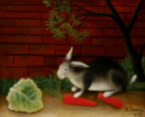
Artist Jay Rolfe's photo of the day is the version of Marcel Duchamp's "Bicycle Wheel" in the Museum of Modern Art in NYC. I previously posted the Philadelphia Museum of Art's version of "Bicycle Wheel" on my April 12, 2007 post. Duchamp's seemingly banal sculpture had great importance in the art world. It was the beginning of the very significant change in the definition of art to whatever someone who says they are an artist says is art is art. This "it's art because I'm an artist and I say it' art" trend is one that most people not in the art world don't get at all. And some of us in the art world wonder about too.
Now maybe you can have a better understanding of why the surrealist Duchamp and his "Bicycle Wheel" sculpture figures in some of my works.
Here's a link to the MoMA website page on the "Bicycle Wheel" sculpture. http://www.moma.org/collection/browse_results.php?object_id=81631
Here's an excerpt from the publication "The Museum of Modern Art, MoMA Highlights," revised 2004, 87.
"Bicycle Wheel is Duchamp's first Readymade, a class of artworks that raised fundamental questions about artmaking and, in fact, about art's very definition. This example is actually an "assisted Readymade": a common object (a bicycle wheel) slightly altered, in this case by being mounted upside-down on another common object (a kitchen stool). Duchamp was not the first to kidnap everyday stuff for art; the Cubists had done so in collages, which, however, required aesthetic judgment in the shaping and placing of materials. The Readymade, on the other hand, implied that the production of art need be no more than a matter of selection—of choosing a preexisting object. In radically subverting earlier assumptions about what the artmaking process entailed, this idea had enormous influence on later artists, particularly after the broader dissemination of Duchamp's thought in the 1950s and 1960s.
"The components of Bicycle Wheel, being mass-produced, are anonymous, identical or similar to countless others. In addition, the fact that this version of the piece is not the original seems inconsequential, at least in terms of visual experience. (Having lost the original Bicycle Wheel, Duchamp simply remade it almost four decades later.) Duchamp claimed to like the work's appearance, "to feel that the wheel turning was very soothing." Even now, Bicycle Wheel retains an absurdist visual surprise. Its greatest power, however, is as a conceptual proposition."
This is the latest step of artist Jay Rolfe on his Journey From Starving Artist To 21st Century Picasso. You may view some of Jay Rolfe's Unique Artistic Idea, his Hyper Representational 3-D Shaped Stretched Canvas paintings, on his website at http://www.3dssc.com/. Artist Jay Rolfe hopes you find his works to be the Uplifting Conversation Pieces he intends.


























